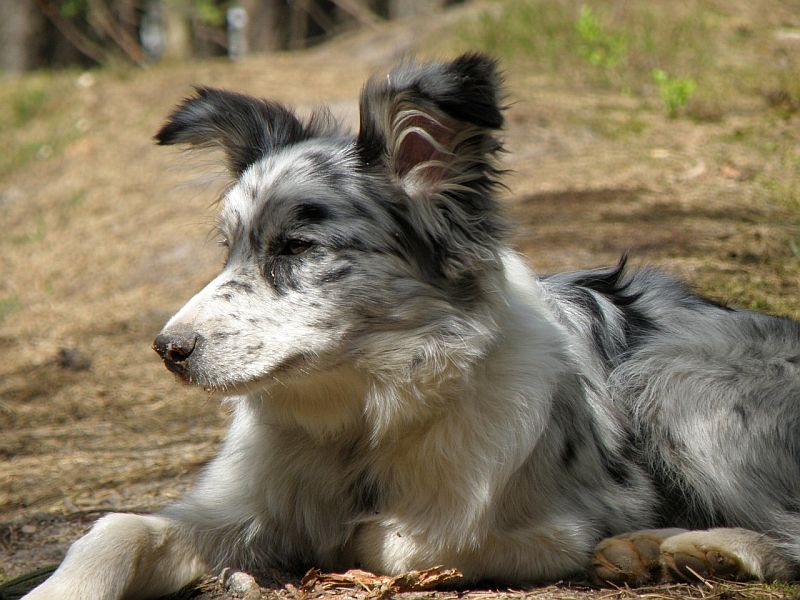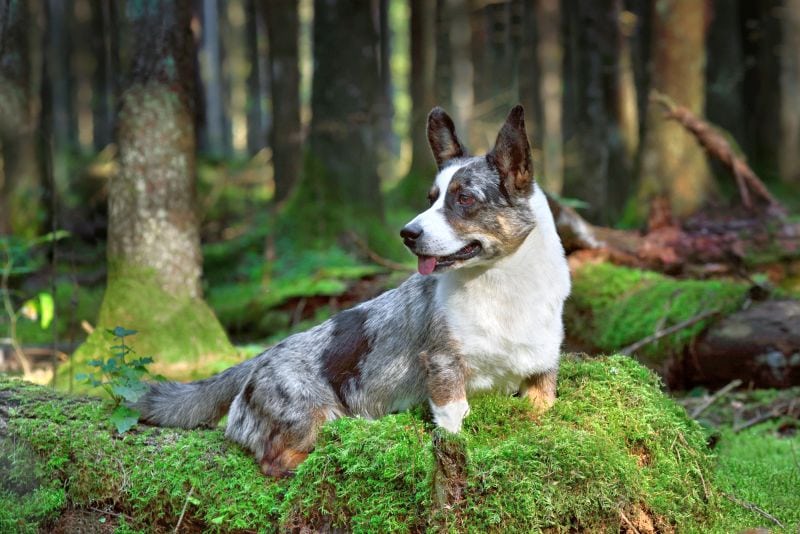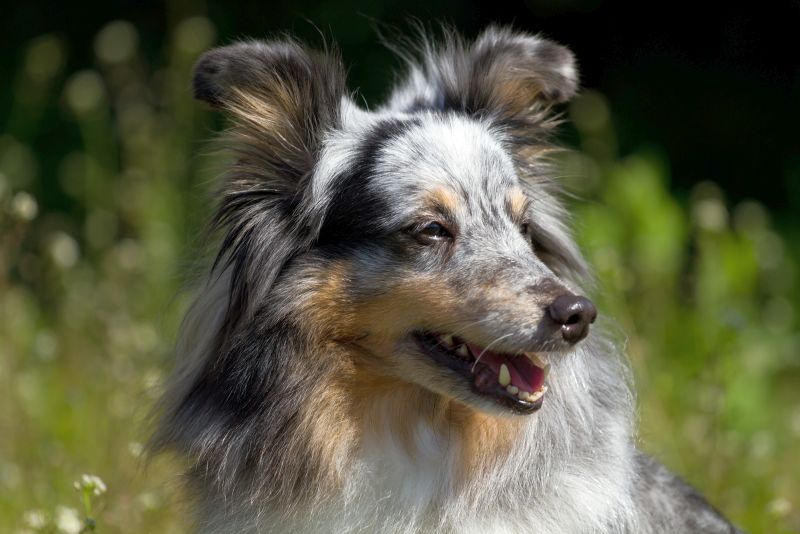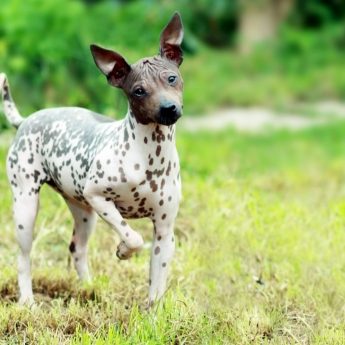Harlequin dogs have a unique coat pattern, consisting of a white base color and scattered patches of black all over their bodies. In some cases, these black patches may even appear blue.
Dog breeds with this coat pattern are very rare.
In fact, there are only two breeds in the world that exhibit this coat pattern. Still, many breeds look similar to harlequin dogs, even if they don’t completely fit the bill.
We will discuss both true harlequin dogs and their look-alikes below, and we’ll also dig into some of the health issues harlequin dogs often experience.
Harlequin Dog Breeds: Key Takeaways
- Harlequin dogs exhibit a unique coat pattern. Their base color is white, and they display a number of black spots and patches all over their bodies. They look somewhat similar to Dalmatians.
- Only two dog breeds can display the harlequin trait: Great Danes and Beaucerons. But because Beaucerons are pretty rare in the U.S., the trait is most commonly associated with Great Danes.
- To exhibit the harlequin coat pattern, a dog needs to have the harlequin gene and the merle gene. However, many dogs who only have the merle gene can appear somewhat similar to harlequins, so we’ll discuss some of the best lookalikes too.
- The merle and harlequin genes are unfortunately linked with several health problems, so it is wise to educate yourself about their potential challenges before adding either to your family.
Deep Dive: What Are Harlequin Dogs?
Harlequin dogs are a bit variable, but most are white and covered with a multitude of black patches.

These patches really can’t be called “spots,” as they are often of varying sizes and shapes. Sometimes, these dogs may have grey ticking (very small grey lines or dots) and patches as well.
Very rarely, the normally dark patches on a harlequin dog might end up being tan, which is referred to as a “fawnequin” coat.
Also, while some harlequin dogs are spotted all over, others may have what is called the “Irish spotting pattern.” This simply means they don’t have spots on their neck, chest, or belly.
But in all of these cases, the same genes are involved.
The harlequin pattern is related to the merle coat pattern, and both involve similar genes. Some dogs with the merle pattern may even look very similar to those with the harlequin pattern.
However, the merle color pattern looks slightly different than the harlequin pattern. Dogs that are just merle will have marbled patches instead of patches that are pure black, grey, or fawn.

For a dog to exhibit the harlequin pattern, he must inherit a merle gene and a harlequin gene from his parents.
A dog with the harlequin gene but no merle gene will just have a standard coat color. The merle gene is required for the harlequin color to become visible.
The harlequin gene causes grey or marbled patches on a merle coat to turn pure white, thereby creating the harlequin coat pattern.
The Harlequin Gene: One Copy Is Great; Two Copies Spell Disaster
The harlequin gene is a dominant gene. There is no other coat color that would “override” this one besides those that turn a dog completely white.
If a dog gets a harlequin gene and a merle gene, it doesn’t matter what other coat genes it gets.

However, the harlequin gene is not an allele (alternative version) of the merle gene — they occur at different places on the dog’s genome. This means that it is possible for a dog to inherit any of three combinations:
- No copies of the harlequin gene
- One copy of the harlequin gene
- Two copies of the harlequin gene
The first two possibilities yield good news, but the last causes a serious problem.
All living harlequin dogs have a harlequin gene and a non-harlequin gene.
This is because any puppy that inherits no harlequin genes will look like a typical doggo, and those who inherit two harlequin genes will not develop properly — it is a fatal gene combination.
Such puppies will sadly die in utero and be reabsorbed by the womb.
Most breeders avoid breeding two harlequin dogs together for this reason. Luckily, you can breed a harlequin dog with a canine that does not have this coat pattern and get some harlequin puppies, since the gene is dominant.
Harlequin dogs can also inherit two different types of merle genes, which can affect their overall coloring.
Harlequin dogs with two dominant merle genes are often very lightly marked with spots, while those with a dominant merle gene and a recessive merle gene appear as a typical harlequin dog.
The Exhaustive List of Harlequin Dog Breeds (Just Kidding – There Are Only Two)
There are only two breeds that can produce harlequin coloration, and only one is particularly popular in the United States.
1. Great Dane

Usually, when you’re talking about harlequin coloration, you’re talking about Great Danes.
The harlequin pattern is one of the seven AKC-recognized coats, but it is important to note that the “fawnequin” pattern is not allowed in the AKC show circuit.
Great Danes are enormous dogs, who can stand as tall as 32 inches at the shoulder. This makes them tower over almost any other dog breed (except perhaps the Irish wolfhound).
Despite their large size, Danes tend to think that they’re lap dogs, however. They are well-known for trying to crawl up in their person’s lap and sit on the couch (even when they’re taller than the couch).
Great Danes are also elegant dogs (aside from their drooling habit), who project a noble vibe.
They are sweet and gentle, but they can still make great watch dogs. Because of their large size, they usually make most intruders think twice, especially if they let out a loud bark.
Great Danes and Great Dane mixes are often good with children. Kiddos are unlikely to hurt the dog, which means the chance of the dog snapping is generally low. They’re also quite patient and will put up with a lot from children, but that doesn’t mean you should leave them unsupervised with small two-footers.
Great Danes do shed seasonally, but their grooming needs are minimal. They don’t need to be brushed often due to their very short fur, and they only need baths a few times a year, or whenever they get dirty.
2. Beauceron

The Beauceron is a rare dog breed in the U.S., but they can also display the harlequin coloration.
Beaucerons are also big dogs, though they are a bit smaller than Great Danes. They typically do not stand higher than 27.5 inches, but they are quite muscular and occasionally approach 100 pounds in weight.
Unlike the Great Dane, the Beauceron requires quite a bit of work. This breed is not for novice owners and is often challenging to train. Still, a well socialized and trained Beauceron is a beautiful sight to behold.
Beaucerons shed a lot and need to be brushed a few times a week, but they don’t need many baths, as their coats tend to stay pretty clean.
A hound-glove is a great way to remove dead hair before it ends up on your clothing. You should also trim their nails regularly and keep their teeth clean. Overall, though, these dogs are not particularly needy when it comes to grooming.
Beaucerons were originally developed to work, so they need lots of exercise. You should expect to give them plenty of room to run, go on a walk or two a day, and be prepared for plenty of playtime in the backyard.
Beaucerons are also quite intelligent, though they can be a bit stubborn. They are well known for becoming very excited, especially with people they know. They are known for jumping on people and “mouthing” them, much like huskies and some other breeds do.
Deeper Than Color: Health Issues of Harlequins
The gene that causes the harlequin coloration does not come without its health effects. Unfortunately, dogs with this coloration are more likely to have several health problems.

This is largely because all harlequin dogs have a merle gene, which is itself associated with some health problems.
Those individuals who inherit two of the dominant forms of the merle gene are even more likely to end up with some sort of health issue.
The issue is so bad that the UK Kennel Club has stopped registering puppies from merle-to-merle matings, as the odds of these puppies inheriting two dominant merle genes is high.
Health problems tend to occur in individuals with two dominant merle genes because they produce minimal pigment. Conversely, those with only one dominant gene produce a bit more pigment, which can help prevent many of these health problems.
Accordingly, it is usually wise to select harlequin dogs with as much coloration as possible. This will help reduce the chances of ending up with a double-dominant doggo.
With that said, it can also be challenging to tell a single merle dog from a regular dog. Some dogs have minimal merle coloration. So, if a dog even has one merle spot, assume he’s a merle.
We discuss some of the most notable health problems in harlequin and merle dogs below.
Higher Risk of Deafness
Much of our knowledge on the effect of the merle gene on deafness is thanks to George Strain, who has published much of the scientific research on this topic.
One of the studies Strain led (along with his colleagues at the Neuroscience Louisiana State University) found that partial hearing loss was found in 54.6% of double merles and 36.8% of single merles, while one out of 11 double merles were found to be entirely deaf.

Another study by Strain yielded similar results. Twenty-two double merle dogs were studied. Out of those 22, eight were completely deaf, and two were partially deaf.
The amount of deafness seems to depend on the breed as well. This same study found that 26% of merle Catahoula leopard dogs were deaf, but 86% of double merles in other breeds were at least partially deaf.
This finding was replicated in another study by Strain in the Veterinary Journal as well.
Potential Vision Problems
The change in pigment production caused by the merle gene also affects vision. But these vision defects vary significantly from one dog to the next.
For example, microphthalmia, problems with eye pressure, and colobomas are all relatively common.
Microphthalmia is simply a condition in which one eye does not develop properly and is smaller than it should be alongside other malformations.
These eyes usually don’t “work.” Colobomas involves a hole somewhere in the eye, which also causes vision problems.
In some cases, merle or harlequin dogs may be both deaf and blind, which is significantly challenging for their owners. The defects do not just occur in blue or light-colored eyes.
Colored eyes can be affected as well. It is the coat color, not the eye color, that matters.
Immune System Issues
It seems that merle dogs might have problems with their immune system as well.
This seems to be the understanding among many breeders, who are usually a good source due to their close work with these dogs.
However, we don’t know precisely what “immune problems” these dogs may have. There have not been any scientific studies to confirm the presence of something wrong with their immune system, either.
Because of this, we can’t say for sure whether these dogs genuinely have an immune system problem, or whether people just consider merle dogs “unhealthy.”
Many breeds that sometimes possess double merle genes suffer from immune system problems whether a particular individual has the merle gene or not, including the Australian shepherd.
Because of that, it’s definitely possible that the cause for these issues is not related to the merle gene.
Neurological Issues
Similarly to the merle gene’s potential connection to immune problems, it is possible — yet not firmly established — that these dogs may be prone to neurological problems.
It is possible that many of the breeds are prone to these issues anyway, and that there isn’t any particular connection to the merle gene.
More studies are necessary before we can say for sure that this coat color is connected to neurological problems. Right now, we just have anecdotal evidence from breeders and others that the merle gene can cause neurological problems.
Reproductive Issues
Merle breeds do not have any problem reproducing in many cases. However, you do have to be very careful about the other dogs you breed them with.
If you breed two merle dogs together, there is a high likelihood that at least some of their puppies will have health problems. Because of this, you should only breed merles with non-merles.
Yet, it can be challenging to figure out which dogs have the merle gene and which don’t.
Often, the coat pattern is a good indicator. However, some merle dogs have very little merle on them, which can make them be mistaken for a non-merle.
Despite their looks, though, their puppies will still be prone to health problems.
Because of the complexity that comes with breeding these dogs, you need to ensure you only acquire merle or harlequin dogs from knowledgeable breeders or shelters.
In fact, many breeders will perform genetic testing to ensure that they don’t breed two merle dogs together.
Harlequin Look-Alikes
Merle dogs can look like Harlequin dogs, but they have different genetics and some apparent physical differences. There are quite a few breeds that can have this coloration.
1. Australian Shepherd

These are some of the smartest dogs in the room. They are high-energy working pups, who require active families to remain happy.
Australian shepherds and Australian shepherd mixes need frequent exercise and lots of mental stimulation with interactive dog toys as well, since they are so intelligent.
If left to their own devices, these dogs will often try to make their own fun (read: chew up everything you own), which is the last thing you want.
2. Chihuahua

This is probably the last dog you’d expect to have a merle coat, but the Chihuahua absolutely can in certain situations.
This coloration is quite rare, but it does occur from time to time.
Despite being the smallest breed in the world, Chihuahuas and Chihuahua mixes make great watchdogs, though they likely won’t be able to do much against an intruder besides bark.
Chihuahuas are also a very long-lived breed, which makes them great long-term companions.
3. Cardigan Welsh Corgi

Though somewhat rare, Cardigan Welsh corgis occasionally display merle color patterns. Originally developed to be herding dogs, these active canines require plenty of exercise and room to roam.
Note that there are two kinds of corgi, but while the Cardigan Welsh corgi occurs in a merle form, the Pembroke Welsh corgi does not occur with a merle coat.
There are a few ways to distinguish these two similar breeds, but the easiest is to simply look for a tail; the Cardigan Welsh corgi has one, while Pembroke Welsh corgi usually does not.
Merle Cardigans are not common canines, which means that it may be challenging to find one in your area.
4. Shetland Sheepdog

The Shetland sheepdog has a lot of hair, and that hair can display a variety of different colors and patterns. While this pooch is traditionally sable, merle variants occur as well.
These dogs were bred to work, so they have significant amounts of energy. They are easy to train and tend to be well behaved too.
They do require a bit of grooming, so only add one of these cuties to your family if you have plenty of time and energy to spare.
5. Catahoula Leopard Dog

The merle pattern is pervasive among Catahoula leopard dogs, and they aren’t too difficult to find either.
This is one of the few breeds that originated in the United States, where they were initially developed to serve many functions, including hunting and guard-dog work.
They were even taken to Venezuela to be herding canines and have completed sled dog races in Canada.
These dogs can be loyal companions, though they need a great deal of exercise and aren’t the easiest dogs to manage. They need plenty of training and mental stimulation, or they may become destructive.
6. Dachshund

Dachshunds come in a “dapple” coloration, which is a version of merle.
This breed was developed in Germany hundreds of years ago to hunt badgers, and their name directly translates into “badger dog.”
Dachshunds need quite a bit of exercise, but only occasional grooming. However, their grooming needs vary depending on their Dachshund coat length; long-haired varieties need more brushing than short-haired ones.
Dachshunds and Dachshund mixed breeds are smart and trainable, though they can have issues with potty training.
7. Collie

It is possible to find the collie in a merle coloration, though this is somewhat unusual.
Still, the combination of the collie’s beautiful locks and the merle pattern is quite a sight!
These famous dog stars of the big screen are very active, so they only fit into active families — plan on exercising Collies plenty and providing regular, daily mental stimulation.
8. Koolie

This unusual breed is also known as the “German collie.” However, they’re really from Australia — they’re not German at all!
Koolies are medium-sized and full of energy. They need a lot of activity, as they were initially bred to work all day. So, you’ll need to be willing to provide them with at least 90 minutes of moderate exercise a day.
Koolies need a quick weekly brushing, but they don’t have any grooming needs besides that.
9. Pit Bull

The term “pit bull” is applied somewhat haphazardly, but it typically refers to the American pit bull terrier. However, American Staffordshire terriers and various pit mixes are sometimes called “pit bulls” too.
Given this, it isn’t surprising to learn that pitties come in all sorts of colors, including the merle pattern.
Pit bulls are smart and loving dogs, who’re typically very easy to train.
However, they need plenty of exercises to curb their inner marathon runners and lots of socialization from a young age. However, they can make great pets for experienced owners.
10. Border Collie

Border collies are typically black-and-white, but they do come in the merle flavor too. They are considered to be one of the most intelligent breeds out there.
They require a lot of work, but their focus and dedication are second to none. Their intelligence can make them challenging for novice owners, but those with plenty of four-footer experience often love them.
Border collies and border collie mixed breeds do require a bit of grooming to keep that long, luxurious coat looking its best, and they’ll thrive best when given a spacious (and fenced) backyard.
11. Pomeranian

While it is rare, the merle coloration does appear sometimes in Pomeranian lines.
These fuzzy dogs have a big personality – and somewhat of a cult following. They are feisty and naturally determined, which makes them effective watchdogs. They don’t back down, even though they are quite small.
Pomeranians are actually a fantastic breed for people who travel a lot, as they are tiny and take new activities in stride.
Harlequin Dog FAQs
Here are some of the most commonly asked questions about harlequin-colored dogs. Hopefully, if you have any more questions, you will find your answer here.
What do harlequin dogs look like?
Harlequin dogs are white with patches of black or grey throughout their body. The exact location of the patches depends on the dog’s specific genes.
Some of these dogs have patches on their stomach and neck as well, while others do not. Fawn colored spots are also possible, but they are rarer.
What’s the difference between harlequin and merle?
Harlequin dogs have white between the darker patches of merle.
Merle dogs often look “marbled.” They have grey coloration alongside black spots.
Harlequin dogs also have the merle gene. However, instead of the larger grey patches, their harlequin gene makes their base coat entirely white.
Truthfully, sometimes it can be difficult to tell the difference. Both of these coat patterns can mirror each other very closely.
What breeds come with a harlequin coat?
The Great Dane and the Beauceron are the only two breeds that display harlequin coats.
However, other breeds do have the merle gene, which may cause them to be mistaken for a harlequin.
Can you tell if a dog has the harlequin gene?
If a dog has a harlequin gene, it will appear in their coat coloration in most cases. There are very few genes that will hide it.
Still, interpreting color combinations and patterns can be a bit subjective, so the only way to know for sure is through genetic testing.
Are harlequin Great Danes susceptible to health problems?
Yes. This is because all harlequin animals have the merle gene, which directly affects the amount of pigmentation they produce. This effect on pigmentation can lead to many different health problems.
Dogs with double merle genes often have significantly more health problems than those with a single copy, and they are almost twice as likely to be blind or deaf.
***
Harlequin dogs look striking and unique, but they’re unfortunately rare — the Great Dane and Beauceron are the only breeds that display this coloration. However, there are many look-alike breeds with merle coats as well.
However, these genes do not just affect their coloration – they can cause health problems as well. This is true for dogs with just the merle gene, including those that aren’t true harlequin. These dogs are more likely to be deaf and blind, which can pose significant problems for everyone.
Do you have a harlequin dog? Thinking about adding one to your family? Or are you going to settle for a look-alike? Let us know in the comments below!







3 Comments
October 29, 2022
This article is factually incorrect. Harlequin can occur in the Australian Shepard. It is a breed genetic Merle color tested with a higher SINE (Check Paw Prints genetic testing for more info). I have 5 harlequin Aussiedoodles as it runs in our lines. It’s a beautiful and rare coat color. ❤️
April 27, 2021
Our new puppy is a rescue. We know his mom is a catahoula. But we do not know the dad. Everyone says our pup looks like a Great Dane and he has the harlequin look.
I’d post a photo if I could.
April 28, 2021
Hey, Deborra.
Check out our photo uploader. It won’t post the pictures publicly here, but we share some of our favorite reader-submitted photos periodically.
🙂